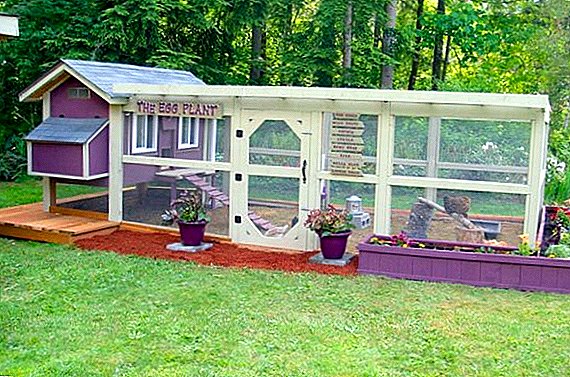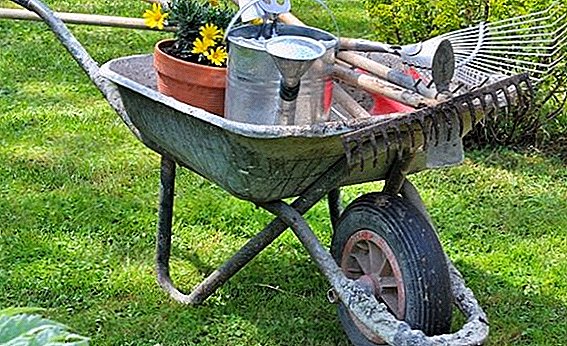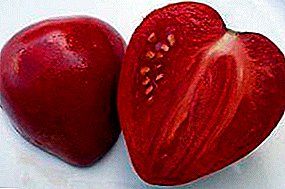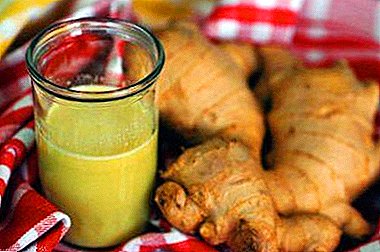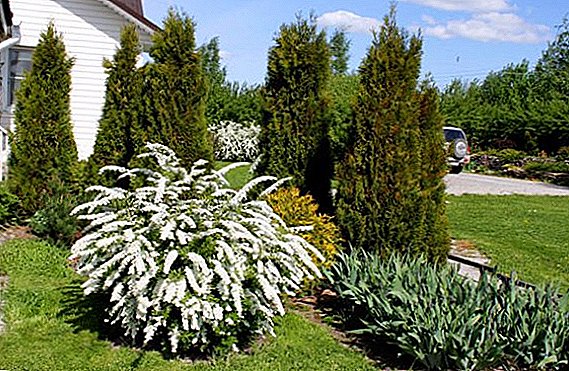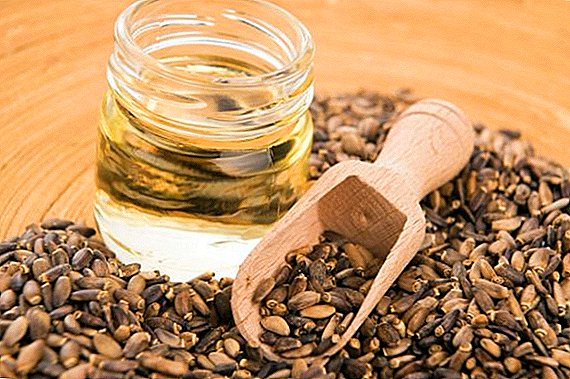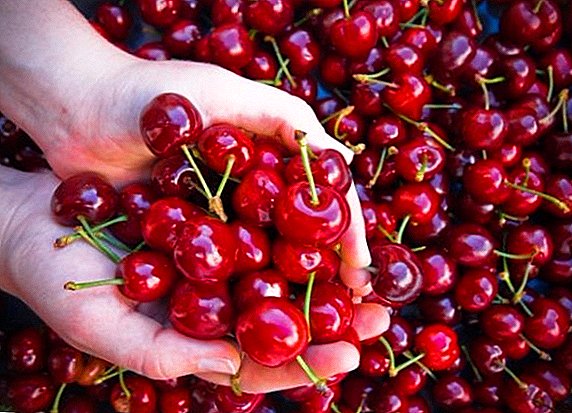 In various forums of gardeners, the cherry "Turgenevskaya" takes pride of place, in particular, in the discussion of the description of varieties: they post photos of their trees, and leave numerous reviews and tips on growing juicy fruits. We will also consider how to grow such a cherry in our garden.
In various forums of gardeners, the cherry "Turgenevskaya" takes pride of place, in particular, in the discussion of the description of varieties: they post photos of their trees, and leave numerous reviews and tips on growing juicy fruits. We will also consider how to grow such a cherry in our garden.
Cherry "Turgenevka": description of the variety
The cherry variety "Turgenevka" appeared in 1979 as a result of several years of work of breeders and within a few years became one of the most popular among summer residents and gardeners. The tree grows up to 3 m tall with a straight raised sprawling crown, branches of medium thickness, straight, the bark of the trunk and branches are brown-gray. Leaves are saturated green, oblong, with the pointed end and the jagged edge. Cherry blossoms in mid-May with inflorescences of four white flowers, and berries ripen in mid-July.  The fruits of the Turgenevka cherry have the following description: the berries are large and juicy, the weight of each is 5-6 g, the diameter is about 20 mm. The stone occupies a tenth of the berry and is easily separated. In Turgenevka cherry, the berries ripen almost simultaneously, their taste is sweet and sour with a long aftertaste and pleasant aroma. Cherry fruits contain vitamins B1, B6, C. Also, they contain substances such as iron, magnesium, cobalt, coumarin and anthocyanin.
The fruits of the Turgenevka cherry have the following description: the berries are large and juicy, the weight of each is 5-6 g, the diameter is about 20 mm. The stone occupies a tenth of the berry and is easily separated. In Turgenevka cherry, the berries ripen almost simultaneously, their taste is sweet and sour with a long aftertaste and pleasant aroma. Cherry fruits contain vitamins B1, B6, C. Also, they contain substances such as iron, magnesium, cobalt, coumarin and anthocyanin.
Eating the fruits of "Turgenevka" helps to reduce blood clotting and strengthen the heart muscle. Eating cherry berries "Turgenev" is a good prevention of anemia. Fruits are tasty when consumed fresh, baked and preserved, suitable for freezing. In addition, the yield of "Turgenevka" is high, and its berries tolerate transportation.
Features of the cultivation of cherry "Turgenevka": the choice of location
 Cherry "Turgenevka" is not too demanding for planting and further care, but there are some features. Sapling is not recommended to be planted in a lowland location, as well as in a draft. The plant is resistant, but for a good harvest it is better to provide him a sunny plot. The optimum location will be the south-western, western or southern slope, since excessive moisture will not linger in the soil, and the cold air masses bypass the tree.
Cherry "Turgenevka" is not too demanding for planting and further care, but there are some features. Sapling is not recommended to be planted in a lowland location, as well as in a draft. The plant is resistant, but for a good harvest it is better to provide him a sunny plot. The optimum location will be the south-western, western or southern slope, since excessive moisture will not linger in the soil, and the cold air masses bypass the tree.
Important! For planting cherries, it is necessary to use an annual sapling; if he is more than two years old, he can take root badly and be ill.
Climatic conditions for growing cherries
Cherry "Turgenev" is able to withstand low temperatures in winter, to tolerate frost and icing. This variety grows in almost any climate of the middle zone, capable of withstanding 30-33 degrees of frost, provided there are no sharp repeated temperature fluctuations.
What soil loves cherry "Turgenevka"
 The land in which the tree will grow should be of neutral acidity, preferably of sandy sand. When planting varieties of cherries "Turgenevka" should be avoided marshy and over-wetted soil, which will negatively affect the development of the plant and its yield in the end. The depth of the groundwater should not be less than 150 cm from the surface of the earth. When planting seedlings clay soil should be mixed with sand.
The land in which the tree will grow should be of neutral acidity, preferably of sandy sand. When planting varieties of cherries "Turgenevka" should be avoided marshy and over-wetted soil, which will negatively affect the development of the plant and its yield in the end. The depth of the groundwater should not be less than 150 cm from the surface of the earth. When planting seedlings clay soil should be mixed with sand.
In order for the seedling to settle down better, you can make a nutrient mixture and dilute the soil in which the tree will grow. To do this, you need 5 kg of humus, 200 g of wood ash, 100 g of superphosphate and 30 g of potash fertilizer.
Did you know? One cherry tree "Turgenevki" can deform up to 25 kg of berries.
Planting "Turgenev" cherry
Planting cherries "Turgenev" produced in the spring before the blooming of the kidneys, for better adaptation to the new location and active growth of the tree. If desired, seedlings can be planted in the fall, in which case the cherry will be better adapted to the climatic conditions of its growth. For the "Turgenevka" dig a hole to a depth of half a meter and a diameter of 0.5-0.7 m, it is better to dig a hole for 7-20 days before landing, so that the earth has time to settle. If the cherry grows among other trees, the distance to the nearest stem should be at least 2 m.
The seedling is preliminarily held for 3-4 hours in water, so that the roots fill in the moisture, the well is filled with the nutrient mixture described earlier, the seedling is set and the root system is carefully poured with the mixture without root penetration. A cherry seedling is dug around with a surrounding roller, poured a bucket of warm water and mulch the soil around the tree with peat. After that, the seedling is tied to a wooden vertical peg to maintain the plant. 
How to care for cherry varieties "Turgenevka"
Caring for "Turgenev" during cultivation is not difficult and not even the most experienced gardener. For wintering, it is better to cover the tree, thereby reducing the likelihood of frostbite with sudden changes in air temperature, and to grind the basal area with sawdust or peat.
Watering and feeding plants
After planting, the cherry seedling is watered almost every day, as the soil dries, but it is necessary to avoid over-wetting and moisture stagnation. Watering is performed within the surrounding roller, the same hole and fertilized with mineral fertilizer once a year, in the spring. After the cherry begins to bear fruit, fertilizer is applied after harvesting in the summer. Organic fertilizer (poultry or cow dung) is applied every two to three years in two steps: the first time is applied after the cherry has faded, and then a second time during fruiting in the middle of summer. During the ripening of the fruit, cherries require more abundant watering.
Important! For the prevention of fungal diseases of the cherry, it is recommended to plant the seedling in early spring, before bud break.
Soil care
After watering, the soil dries out and becomes covered with a dry crust, it must be carefully loosened to a depth of 7-10 cm for oxygen to reach the roots of the tree. Weeds should be removed after the appearance. Also be cut the root cherry growth, which will weaken the tree, taking him juice.
How to form the crown of Turgenev cherry
For good plant development and high-quality fruiting, pruning is necessary to form a crown of cherries and cutting dry branches. Pruning can be done on a wintered tree in early spring. In place of the cut should be applied garden var for the speedy healing of the tree. Pruning before fruiting begins, forms the crown of the cherry, and after the appearance of the first fruits, performs sanitary functions. It is recommended to cut the branches on which shoots grow longer than half a meter, as well as branches that grow at a height of less than 0.4 m from ground level.  After the first winter of a sapling, it is pruned to five basic strong branches directed in different directions from the trunk. Subsequently, the crown of the cherries is shaped, avoiding the thickening of the branches, and also remove the branches growing high. Diseased and dry branches should be cut off as they are detected. Shortening one-year shoots is required for the growth of side branches. Fruiting cherry rejuvenate, cutting off the side branches, thereby stimulating the growth of young shoots. If necessary, pruning is carried out in the fall until frost, remove diseased and dry shoots and thin out the branches of the crown.
After the first winter of a sapling, it is pruned to five basic strong branches directed in different directions from the trunk. Subsequently, the crown of the cherries is shaped, avoiding the thickening of the branches, and also remove the branches growing high. Diseased and dry branches should be cut off as they are detected. Shortening one-year shoots is required for the growth of side branches. Fruiting cherry rejuvenate, cutting off the side branches, thereby stimulating the growth of young shoots. If necessary, pruning is carried out in the fall until frost, remove diseased and dry shoots and thin out the branches of the crown.
Did you know? Abundantly blooming Japanese cherry - Sakura - is a harbinger of a good rice harvest.
Diseases and pests "Turgenevki"
The most common diseases of the cherry "Turgenevka":
- Kokkomikoz - defeat cherry fungi, parasites, the most favorable conditions for the development of the disease - warm moist air for a long time. The disease manifests itself in the summer as yellowing and redness of the foliage, over time the leaves become covered with dark tints, dry out and fall off, possibly skeletonization of the leaf. Spores of the fungus overwinter in damage to the bark, on the ground and plant debris, on leaves and fruits that are not fallen. To get rid of coccomycosis can be done by treating the wood with Bordeaux mixture, the fallen yellowed foliage should be destroyed.
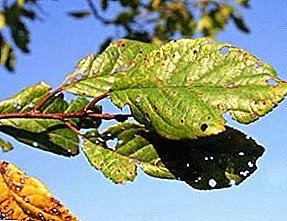 Klesterosporiosis is a fungal disease that appears on the leaves with brown spots; after 2-3 weeks, infected leaves fall off; brown areas are affected by the fruit, which is then deformed and dries out. Bark bursts, gum stands out. The affected parts of the plant are subject to cutting and burning, the deformed bark with gum extraction sites is treated with garden pitch, the tree is sprayed with “Topsin” or “Early”.
Klesterosporiosis is a fungal disease that appears on the leaves with brown spots; after 2-3 weeks, infected leaves fall off; brown areas are affected by the fruit, which is then deformed and dries out. Bark bursts, gum stands out. The affected parts of the plant are subject to cutting and burning, the deformed bark with gum extraction sites is treated with garden pitch, the tree is sprayed with “Topsin” or “Early”.- Moniliasis is a fungal disease that affects the inflorescences; if left untreated, the branches of the cherries dry up, the leaves, bark and berries become covered with a gray crust, the branches crack, and as a result the tree dies. It is possible to get rid of the disease in the same way as for phytosteriasis.
- Anthracnose is a fungal disease affecting the fruit, manifested by a dull type of berries, which are then covered with growths, and a pinkish bloom of the mycelium of the fungus. It is possible to get rid of anthracnosis by processing "Poliram" before flowering, after it, and again 15 days later.
- Rust - appears brown convex spots on the leaves. Affected leaves must be cut and destroyed, and the wood must be treated with Bordeaux mixture.
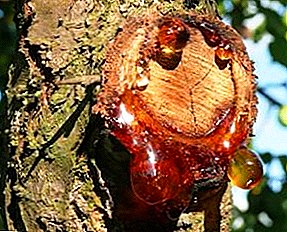 Gum therapy - occurs due to mechanical damage to the bark, manifested by the release of yellow-brown resin - gum, the disease can cause the death of the tree. The affected areas are cleaned and treated with blue vitriol. As a preventive measure, whitewashing is shown.
Gum therapy - occurs due to mechanical damage to the bark, manifested by the release of yellow-brown resin - gum, the disease can cause the death of the tree. The affected areas are cleaned and treated with blue vitriol. As a preventive measure, whitewashing is shown.
- Cherry aphid - shows up on twisted leaves at the ends of branches and young shoots from late spring to early summer. To get rid of the pest cherries are sprayed with Aktar or Fufanon.
- Cherry fly - manifests itself from May to June with black patches of berries, which subsequently rot. You can overcome a fly with the help of "Agravertin", "Aktellika" or "Fitoverma".
- Cherry slimy sawfly - manifested during the summer by the appearance of black thin larvae on the leaves. To combat sawflies, spraying the tree with Confidor is carried out.
- Cherry shoots moth - manifested damage to young leaves, possibly a defeat the entire season. Plant residues must be removed from the site and burned. Get rid of the moth wood treatment "Aktellikom" or "Fufanon."
- Winter moth - manifested in the fall of leaf weaving, weaving a sheet plate. Will help to get rid of "Mospilan" and "Aktar", divorced in accordance with the instructions.
- Yellow plum sawfly - manifested in May by the departure of bugs before the blooming of cherry flowers. Preparations "Fitoverm" and "Agravertin" successfully rid of the sawfly.
Cherry "Turgenevka": harvesting
 After 4-5 years after the seedling was planted, the first fruits appear, which ripen almost simultaneously, in the middle of summer. Ripe berries fall off. Harvesting is preferably carried out in the morning on a dry day. For better preservation, the cherry is removed from the tree with a stem. The harvest in plastic boxes or wicker baskets is stored for up to two weeks at a temperature of -1 ... +1 ° С and high humidity. For long storage of fruits they are packaged in a plastic bag and placed in a freezer.
After 4-5 years after the seedling was planted, the first fruits appear, which ripen almost simultaneously, in the middle of summer. Ripe berries fall off. Harvesting is preferably carried out in the morning on a dry day. For better preservation, the cherry is removed from the tree with a stem. The harvest in plastic boxes or wicker baskets is stored for up to two weeks at a temperature of -1 ... +1 ° С and high humidity. For long storage of fruits they are packaged in a plastic bag and placed in a freezer.
Advantages and disadvantages of the "Turgenevka" variety
Cherry "Turgenevka" among gardeners is considered one of the best varieties of cherries for its unpretentiousness and generous tasty harvest. The advantage of the berries are taste, small, easily detachable bone, relatively long storage of fresh fruits. The berries retain their marketable appearance and are in demand among buyers, which is pleasant to gardeners selling their crops.
Did you know? In England, growing fruiting cherry, which has already turned 150 years old, with the diameter of its crown more than 5 m, and height - more than 13 m.
The disadvantage of this type of cherry is considered to be poor frost resistance of flower buds. With a sudden freeze, after the kidneys have already started, the probability of the crop dying is high. In the summer, the tree needs watering because it reacts poorly to dry conditions. A relative disadvantage is the need for pollinators for Turgenevka cherries, since it is partially self-fruited. To do this, you need to plant cherries of the variety “Favorite”, “Youth” or “Melitopol Joy” at a distance of up to 35 meters, or at least plant a branch of a pollinator tree on “Turgenevka”.
Multiple advantages exceed the disadvantages, and for many years Turgenevskaya Cherry generously gives the gardeners juicy bright fruits.


 Klesterosporiosis is a fungal disease that appears on the leaves with brown spots; after 2-3 weeks, infected leaves fall off; brown areas are affected by the fruit, which is then deformed and dries out. Bark bursts, gum stands out. The affected parts of the plant are subject to cutting and burning, the deformed bark with gum extraction sites is treated with garden pitch, the tree is sprayed with “Topsin” or “Early”.
Klesterosporiosis is a fungal disease that appears on the leaves with brown spots; after 2-3 weeks, infected leaves fall off; brown areas are affected by the fruit, which is then deformed and dries out. Bark bursts, gum stands out. The affected parts of the plant are subject to cutting and burning, the deformed bark with gum extraction sites is treated with garden pitch, the tree is sprayed with “Topsin” or “Early”. Gum therapy - occurs due to mechanical damage to the bark, manifested by the release of yellow-brown resin - gum, the disease can cause the death of the tree. The affected areas are cleaned and treated with blue vitriol. As a preventive measure, whitewashing is shown.
Gum therapy - occurs due to mechanical damage to the bark, manifested by the release of yellow-brown resin - gum, the disease can cause the death of the tree. The affected areas are cleaned and treated with blue vitriol. As a preventive measure, whitewashing is shown.